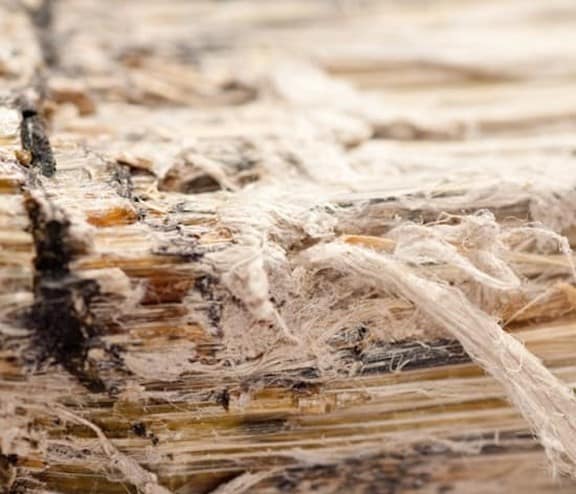
Everything you need to know about working safely with asbestos
Britons have the world’s highest chances of developing mesothelioma due to asbestos exposure according to IOSH, while HSE estimates that 20 tradesmen per week are killed following exposure to asbestos.
Due to its prolific use in the construction of Britain’s buildings throughout the 20th century, many employees could be working near asbestos.
That’s why it’s important to be aware of how to work safely around asbestos, how to avoid coming into contact with it and how to safely dispose of asbestos-contaminated hazardous waste should you need to.
Who is likely to be working with asbestos?
It’s highly likely that most employees will never be exposed to asbestos’ dangerous nature as long as it remains undisturbed.
Some trades involve a risk to asbestos exposure, especially if daily tasks require altering the structure of buildings or working near damaged or unstable buildings built before 2000.
Occupations where asbestos is considered a workplace hazard:
- Construction and demolition contractors
- Firefighters
- Industrial workers
- Tradesmen
- Surveyors
- Telecommunications engineers
- Maintenance engineers
Why was asbestos used in the construction industry?
Widely used during the construction of commercial and domestic buildings during the 20th century, asbestos was a typical element in insulation, panelling, floor tiles and roof sheeting. It was also readily used for decorative purposes such as Artex.
At its peak use, the UK was importing over 170,000 tonnes of asbestos each year because of its appealing properties ideal for construction. Asbestos was frequently used during the 1960s and 1970s because it was:
- Cheap
- Widely available
- Strong
- Insulating
- Fire resistant
- Heat resistant
- Sound absorbing
Despite its useful elements, the devastating effects that manifest decades later led to its prohibition in 1999.
Where can you find asbestos?
Before it was banned, asbestos incorporated hundreds of thousands of construction, commercial and household products. According to the Institution of Occupational Safety and Health (IOSH), there are potentially half a million UK buildings containing asbestos.
Commonly used uses for asbestos in properties included:
- Fireproof coatings
- Concrete and cement
- Bricks
- Pipes
- Gaskets
- Insulation
- Drywall
- Flooring
- Roofing
- Joint compound
- Paints and sealants
What is so dangerous about asbestos?
If asbestos is cut, drilled or broken, dust filled with microscopic needle-like fibres become airborne and can be breathed in or ingested. These fibres are so small that they can easily pass through a regular dust mask.Due to the remarkable strength of these fibres, the body cannot break them down meaning they remain in the lungs for decades, causing long term damage and disease.

What are the health hazards associated with asbestos?
Any exposure to asbestos fibres is bad for you, but long term and multiple exposures can cause life-altering or fatal diseases.Mesothelioma – a cancer of the lung lining. It is always fatal and almost exclusively caused by exposure to asbestos.
Asbestos-related lung cancer – this is almost always fatal.
Other serious lung diseases also attributed to asbestos include:
Asbestosis – a scarring of the lungs. It is not always fatal but can be a very debilitating disease, significantly affecting the quality of life.
Diffuse pleural thickening – a thickening of the membrane surrounding the lungs, restricting lung expansion leading to breathlessness.
Symptoms of these diseases are not immediately apparent and can take 15-60 years to materialise, which is why the UK is seeing an increase in asbestos-related deaths, two decades after its ban.
How are employees protected from asbestos?
In the UK, the building owner or whoever is responsible for the maintenance of a non-residential property has a duty to manage asbestos as well as the health and safety of anyone in the building. This includes keeping records of asbestos or potential asbestos containing materials, its location and condition.That person must also assess the risks of anyone coming into contact with asbestos and prepare a plan to manage exposure to anyone coming onto the property.
How to avoid asbestos in the workplace
If your daily work doesn’t involve maintenance or engineering work on a building, it should be reasonably straightforward to avoid contact with asbestos.Asbestos is only harmful when broken as it emits fibres into the air which cling to your hair, clothes and skin. Avoid tampering with pipe insulation and ceiling tiles in old commercial buildings built in the 1960s and 70s.
How to work safely with asbestos if you’re a tradesperson
If you’re a tradesperson, engineer or surveyor and may find yourself working with asbestos, it’s important to be able to identify these situations before getting on-site.
Have all the necessary training
Employees and supervisors need to have the appropriate training for any work being carried out with asbestos. Anyone with the potential to disturb asbestos should undertake an asbestos awareness course to understand how best to avoid contact.
Workers that will be carrying out work that will disrupt asbestos, such as drilling holes or laying cables require a higher level of information, instruction and training in addition to asbestos awareness.
Assess the working conditions
For non-domestic premises, the person managing the property should provide you with information if there is asbestos and what condition it is in.
If no information is available but you suspect asbestos may be present in the area you are going to work on, then samples should be collected and analysed or proceed with the assumption it is asbestos.
Carry out a risk assessment
Produce a risk assessment and determine if it’s possible to carry out the building or maintenance work and avoid the risk of asbestos exposure altogether.
If contact with asbestos is unavoidable, the next step is to identify who might be at risk and the level of possible asbestos exposure from any work and the necessary approach to providing effective control of the risks.
Wear the correct PPE
Asbestos has extremely fine, microscopic fibres that can cling to hair, clothes and the skin, so it’s vital that for any work carried out on or around asbestos that you wear the correct personal protective equipment (PPE).
- Type 5 disposable overalls
- Single-use disposable gloves
- Laceless boots
- Use suitable RPE with a UK-assigned protection factor (APF) of 20or more
Hire a professional
For small renovation projects such as installing fixtures and fittings or repairing a small section on piping, the work may be completed yourself.
Remember to follow the risk assessment and to use the correct protective equipment for any work you do with asbestos.
However, sprayed asbestos coatings, asbestos lagging and most work with asbestos insulation or asbestos insulating board (AIB) will require a contractor holding a licence from HSE.
For more information on if you need a licensed contractor or if work needs to be notified, refer to HSE.
How to remove hazardous asbestos waste safely
In England and Wales, asbestos waste is ‘hazardous waste’ or in Scotland ‘special waste’ when it contains more than 0.1 % asbestos and cannot be disposed of like regular construction waste.
For asbestos removal you will need to hold a waste carrier’s licence and must segregate, contain and label any asbestos waste correctly before transporting it to a hazardous waste transfer station.
If you do not have a waste carrier’s licence or the necessary equipment, you must arrange for the asbestos waste to be transport by a registered waste carrier, such as Biffa OneCall.
After you’ve correctly bagged any asbestos contaminated items, don’t forget to wash before taking a break or going home to reduce the risk of taking asbestos fibres with you!
For help or information on safe asbestos removal, call our expert team on 0800 55 11 22.
